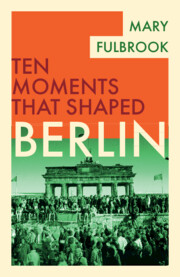Refine search
Actions for selected content:
26 results
Conflicting minds: Immanuel Kant, Johann Daniel Metzger, and the debate about forensic psychiatry
-
- Journal:
- Science in Context , First View
- Published online by Cambridge University Press:
- 01 September 2025, pp. 1-21
-
- Article
-
- You have access
- Open access
- HTML
- Export citation
Villagers as Victims: Different Views of Peasant Oppression in Eighteenth-Century Prussia
-
- Journal:
- Central European History , First View
- Published online by Cambridge University Press:
- 15 July 2025, pp. 1-18
-
- Article
- Export citation
4 - From International Hierarchy to Balance of Power
- from Part II - Introduction: From Universal Monarchy to Territorial Balance of Power
-
- Book:
- Representants and International Orders
- Published online:
- 15 May 2025
- Print publication:
- 08 May 2025, pp 113-154
-
- Chapter
- Export citation

Berlin
-
- Published online:
- 13 February 2025
- Print publication:
- 30 January 2025
3 - Absolutism and Enlightenment
-
- Book:
- Berlin
- Published online:
- 13 February 2025
- Print publication:
- 30 January 2025, pp 38-56
-
- Chapter
- Export citation
24 - Hohenzollern Strategy under Frederick II
-
-
- Book:
- The Cambridge History of Strategy
- Published online:
- 06 January 2025
- Print publication:
- 09 January 2025, pp 488-507
-
- Chapter
- Export citation
3 - The Half-Open Society
- from Part I - Learning to Know Germany: 1780–1840
-
- Book:
- Germany through Jewish Eyes
- Published online:
- 14 November 2024
- Print publication:
- 21 November 2024, pp 44-60
-
- Chapter
- Export citation
6 - The Politics of Secularism 1905–1914
-
- Book:
- Red Secularism
- Published online:
- 30 November 2023
- Print publication:
- 30 November 2023, pp 153-195
-
- Chapter
- Export citation
8 - Prussia’s Debasement during the Seven Years War: the Role of the Bank
-
- Book:
- How a Ledger Became a Central Bank
- Published online:
- 16 November 2023
- Print publication:
- 30 November 2023, pp 205-242
-
- Chapter
- Export citation
18 - Germany and the French Revolution
- from Part II - Western, Central, and Eastern Europe
-
-
- Book:
- The Cambridge History of the Age of Atlantic Revolutions
- Published online:
- 18 October 2023
- Print publication:
- 09 November 2023, pp 467-489
-
- Chapter
- Export citation
4 - Exogenous Loss of Labor
-
- Book:
- Shocking Contrasts
- Published online:
- 09 June 2023
- Print publication:
- 17 August 2023, pp 55-82
-
- Chapter
- Export citation
19 - The Campaigns of 1806–7 in Prussia and Poland
- from Part IV - Napoleon’s Military Campaigns in Europe
-
-
- Book:
- The Cambridge History of the Napoleonic Wars
- Published online:
- 20 December 2022
- Print publication:
- 02 March 2023, pp 381-408
-
- Chapter
- Export citation
3 - ‘The Affair of His People’
-
- Book:
- Royal Heirs
- Published online:
- 05 January 2023
- Print publication:
- 12 January 2023, pp 109-175
-
- Chapter
- Export citation
2 - ‘And This Comedy That I Have to Perform before the World’
-
- Book:
- Royal Heirs
- Published online:
- 05 January 2023
- Print publication:
- 12 January 2023, pp 52-108
-
- Chapter
- Export citation
Whither Prussia? Berlin's Humboldt Forum and the Afterlife of a Vanished State
-
- Journal:
- Central European History / Volume 56 / Issue 1 / March 2023
- Published online by Cambridge University Press:
- 30 November 2022, pp. 2-17
- Print publication:
- March 2023
-
- Article
- Export citation
14 - Crossing the False Divide
-
- Book:
- Corruption, Protection and Justice in Medieval Europe
- Published online:
- 12 October 2022
- Print publication:
- 24 November 2022, pp 303-324
-
- Chapter
- Export citation
Introduction
-
- Book:
- The Brothers Grimm and the Making of German Nationalism
- Published online:
- 07 April 2022
- Print publication:
- 14 April 2022, pp 1-21
-
- Chapter
-
- You have access
- Open access
- HTML
- Export citation
12 - German National Identity and Operatic Italianità
-
-
- Book:
- Italian Opera in Global and Transnational Perspective
- Published online:
- 17 March 2022
- Print publication:
- 24 March 2022, pp 239-260
-
- Chapter
- Export citation
Chapter 4 - Enlightenment against Revolution
-
- Book:
- The Case of Ireland
- Published online:
- 27 January 2022
- Print publication:
- 17 February 2022, pp 139-173
-
- Chapter
- Export citation
9 - A Society Safe for Capitalism
- from Part III - Promoting Capitalism
-
-
- Book:
- Reshaping Capitalism in Weimar and Nazi Germany
- Published online:
- 20 January 2022
- Print publication:
- 03 February 2022, pp 232-254
-
- Chapter
- Export citation
